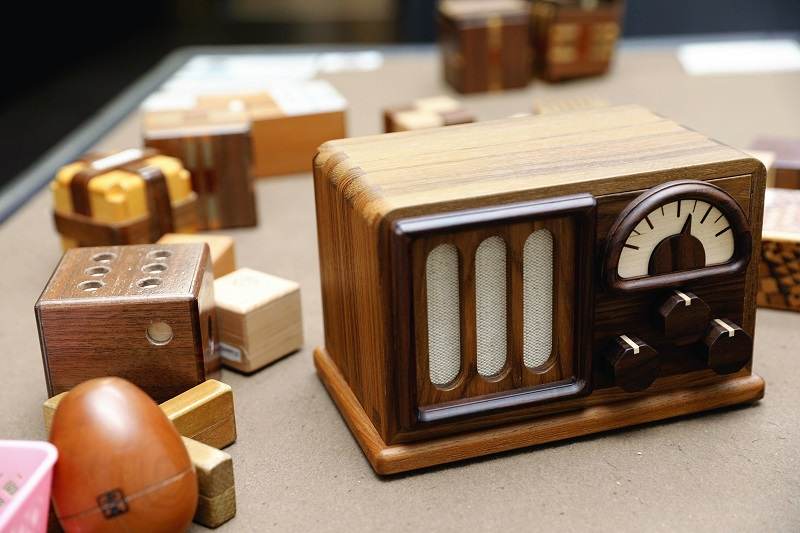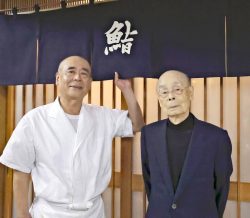
Visitors shake puzzle boxes as they try to open them at the Hakone Karakuri Museum in Hakone, Kanagawa Prefecture.
16:16 JST, March 16, 2021
HAKONE, Kanagawa Pref. — At the Hakone Karakuri Museum, guests turn into puzzle solvers. They can hold, tap, push and shake a variety of ornate wooden puzzle boxes. When the steps are done in the right order, it will open up and the guest can know they have cracked the puzzle.
I picked up a puzzle box, but did not hit upon the proper steps. The wooden contraption wouldn’t open. Feeling like a kid again, I lost track of time trying to get to the bottom of the puzzle box.
Teruchika Maruyama, 83, the former president of Hakone Maruyama Bussan, a Hakone yosegi parquetry shop, established the museum in 2013 across the street from the shop. Maruyama’s eldest son, Ichiro, 55, now passes on parquetry’s appeal of fitting wood together in geometric patterns in the Hakone style, which has been designated as a national traditional handicraft.

Some puzzle boxes are shaped like an egg or radio.
Typically covered in bewilderingly beautiful mosaic patterns, Hakone puzzle boxes are comprised of wooden pieces with grooves and ridges that cannot be smoothly opened unless the lid and sides are moved in the correct order. They are said to have been invented by a craftsman making wooden furniture and components in the town’s Hakone-Yumoto district around 1894. The museum exhibits about 100 of the items, including Maruyama’s collection, as well as the works of modern artisans.
Visitors can touch most of the exhibits on display and many of the boxes can be opened with a few to about a dozen steps — except for one that requires a staggering 1,536 steps. If used to stockpile savings, such puzzles can act as safeguards against reckless withdrawals.
Aside from complex boxes, more playful versions have been created to resemble radios or eggs, and guests are welcome to try their luck at opening die-shaped ones, which can only be opened in an unexpected way.
If visitors get stuck trying to solve the puzzles, staff are available to offer guidance.
The museum also exhibits “puzzle furniture” — desks and chests built with techniques derived from the puzzle boxes — and there’s also a workshop that teaches guests how to make their own puzzle boxes.
The museum provides the distinctive opportunity to learn more about the sophistication of traditional crafts as well as Japanese puzzle culture.
“Puzzle boxes are highly appreciated overseas,” Ichiro Maruyama said. “I want many people to come in contact with these traditional crafts that Japan is proud of and feel the excitement of opening them.”
Another point of interest is the museum’s wooden front door, which also has some tricks embedded in it.
By passing through this door, a visitor can stimulate their intellectual curiosity, focus their mind, and open up some secrets around them.

Even opening the museum’s entrance door requires solving a puzzle.
Related Tags
"Features" POPULAR ARTICLE
-

Sanrio to Open Museum in Yamanashi Pref. Dedicated to Founder, Exhibits Include Hello Kitty, Other Characters
-

Legendary Sushi Chef Jiro Ono Turns 100: ‘I Have No Regrets’
-

Autumn Foliage Surrounds Visitors to Tokyo’s Showa Kinen Park
-

My Daughter No Longer Speaks to Me, But I Want to See Her and My Grandchild
-

Kumamoto: Public Bath Refurbished as Library Where You Can Chat, Take Photos
JN ACCESS RANKING
-

Keidanren Chairman Yoshinobu Tsutsui Visits Kashiwazaki-Kariwa Nuclear Power Plant; Inspects New Emergency Safety System
-

Imports of Rare Earths from China Facing Delays, May Be Caused by Deterioration of Japan-China Relations
-

University of Tokyo Professor Discusses Japanese Economic Security in Interview Ahead of Forum
-

Japan Pulls out of Vietnam Nuclear Project, Complicating Hanoi’s Power Plans
-

Govt Aims to Expand NISA Program Lineup, Abolish Age Restriction

























